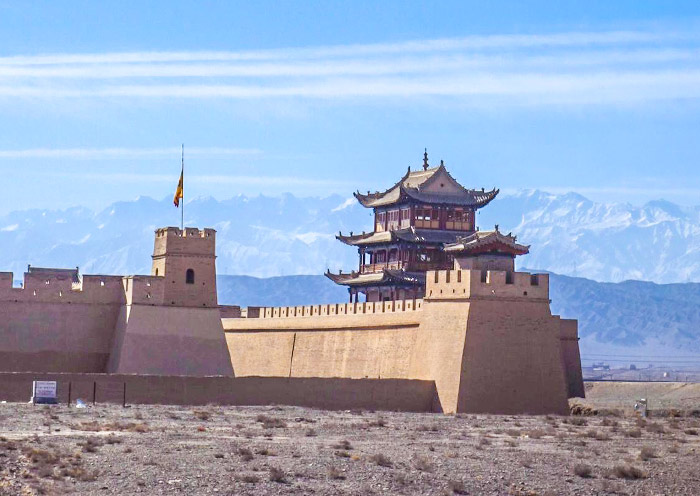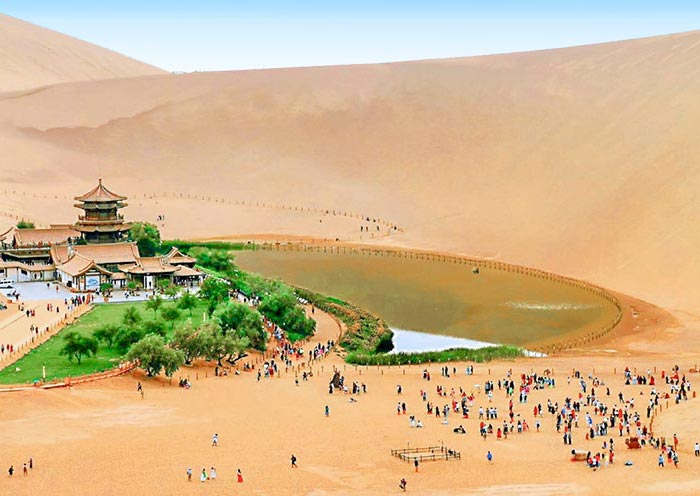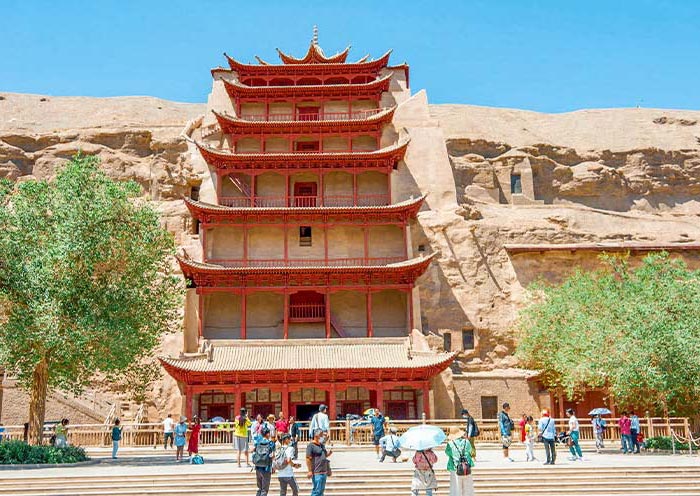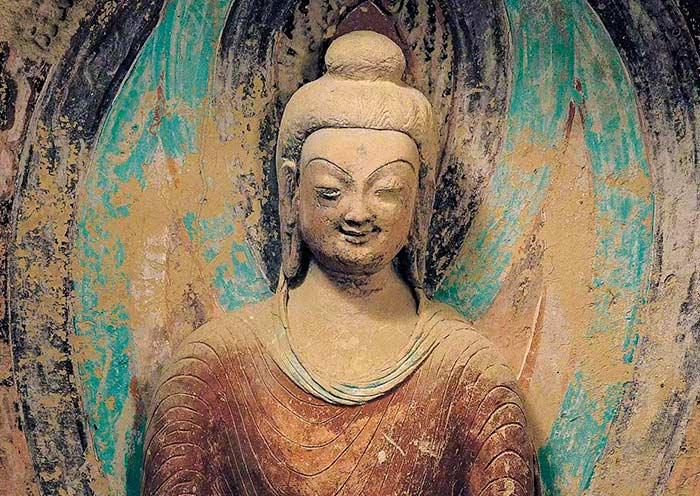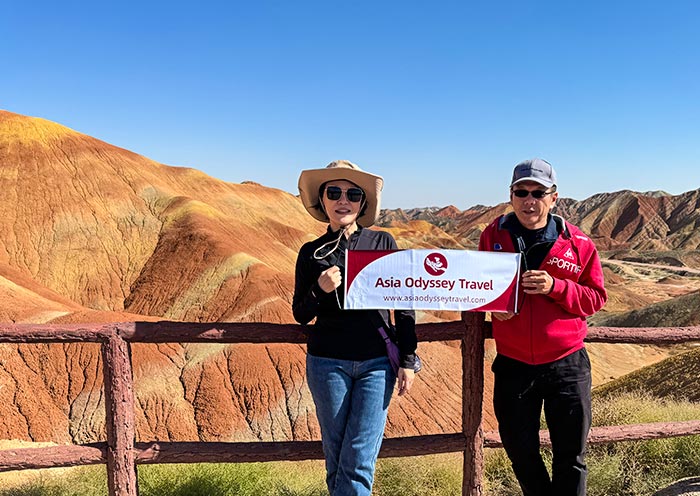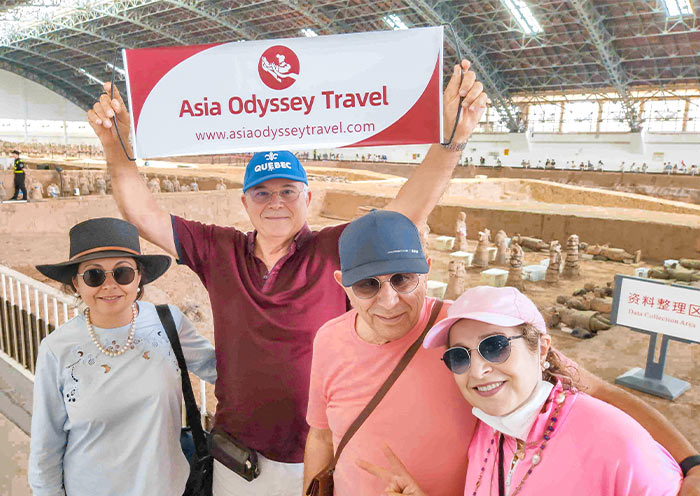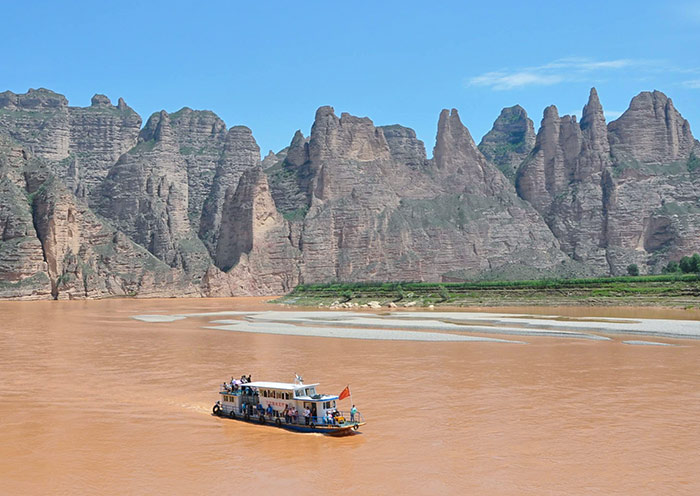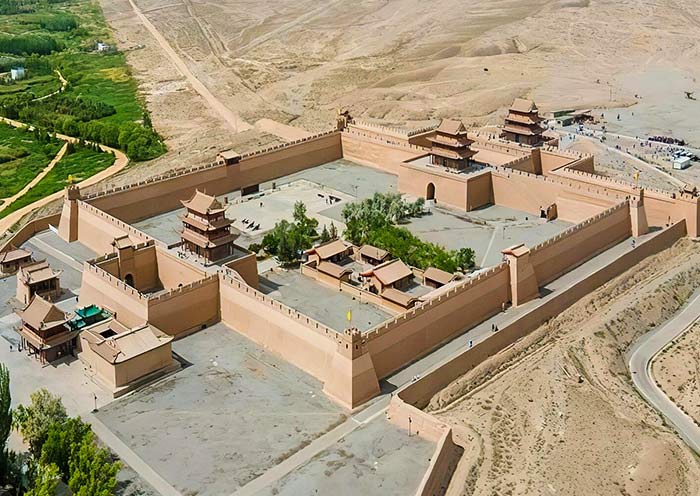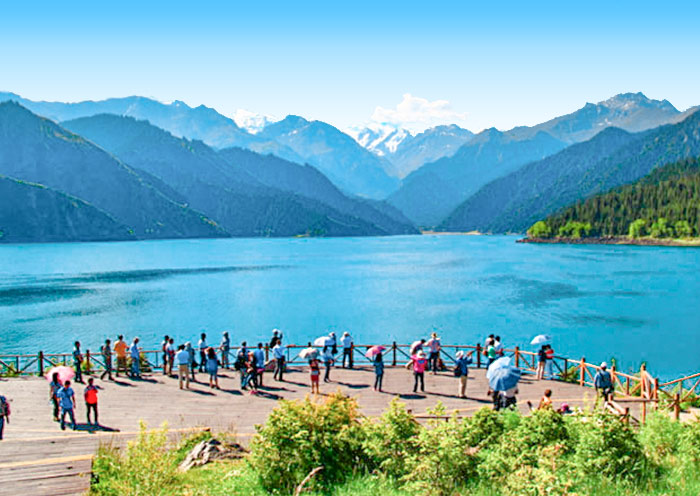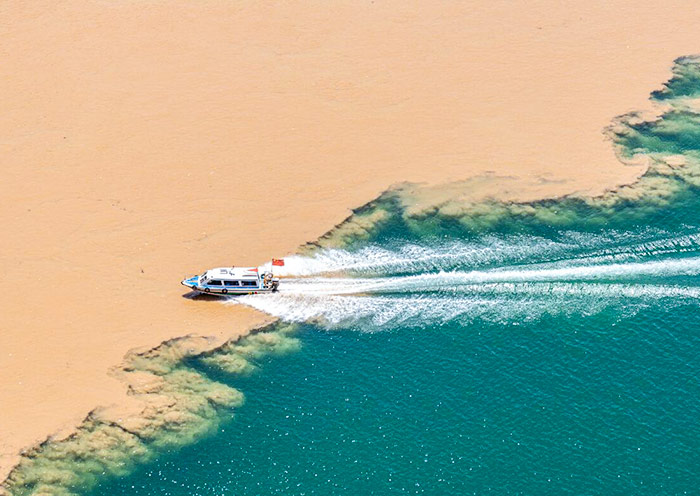Our 8 days group tour in December was amazing! Tokyo’s vibrant streets and Mount Fuji’s snow-capped beauty were breathtaking. Kyoto’s temples and Nara’s deer park offered a serene charm, while Osaka dazzled with its food and nightlife. Hiroshima’s Peace Memorial Park was deeply moving. The crisp winter atmosphere and festive illuminations added a magical touch. Traveling with a small group made the experience fun, seamless, and unforgettable!
6 Days Best Gansu Tour from Dunhuang to Jiayuguan & Zhangye
- Highlights
- Itinerary
- Price
- Trip Notes
- Accommodation
- Photos
- Reviews
Gansu Silk Road Tour: Mogao Caves, Great Wall & Danxia Landscape
Why choose a Gansu Tour? Gansu, known as the Gansu Corridor (Hexi Corridor), , lies along the crucial path of the Silk Road leading to the Western Regions. Take our 6 Days Best Gansu Tour from Dunhuang to Jiayuguan & Zhangye, to experience the diverse landscapes of Gansu, including snow-capped mountains, plateaus, canyons, deserts, rivers, lakes, forests, and grasslands, as well as its rich cultural heritage showcased in sites like the Mogao Caves, the Great Wall at Jiayuguan, and the Mati Temple Grottoes. Contact us to plan your Gansu Silk Road Tour and discover the Best of Gansu.
Our Best Gansu Tour will take you to the Top Destinations in Gansu, such as Mogao Grottoes (World Heritage),the Singing Sand Dunes & Crescent Lake (First Spring in the Desert), the Overhanging Great Wall, Jiayuguan Pass (World Heritage - Great Wall of China), Zhangye Dafo Temple (rumored birthplace of Kublai Khan), Zhangye Danxia Geopark (Rainbow Mountains), the Zhangye Pingshan Lake Grand Canyon (a hidden gem along the Silk Road), and Mati Temple Grottoes (Little Switzerland & Tibetan Culture).
Take our 6 Days Best Gansu Tour to witness the natural marvels sculpted by nature and the cultural wonders etched by the ancient Silk Road in the Gansu Corridor.
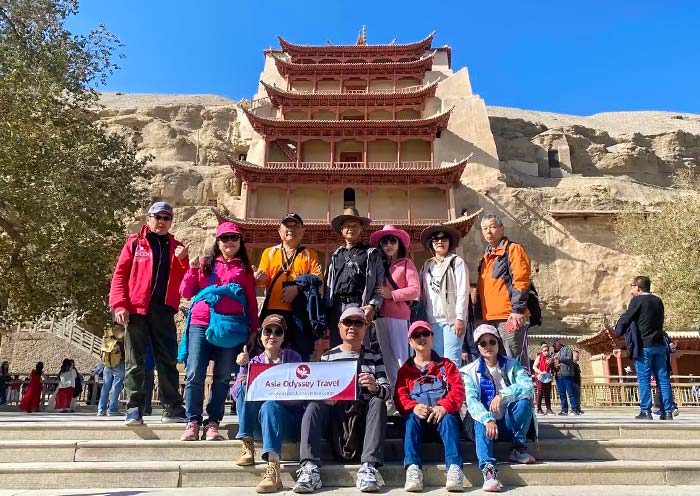
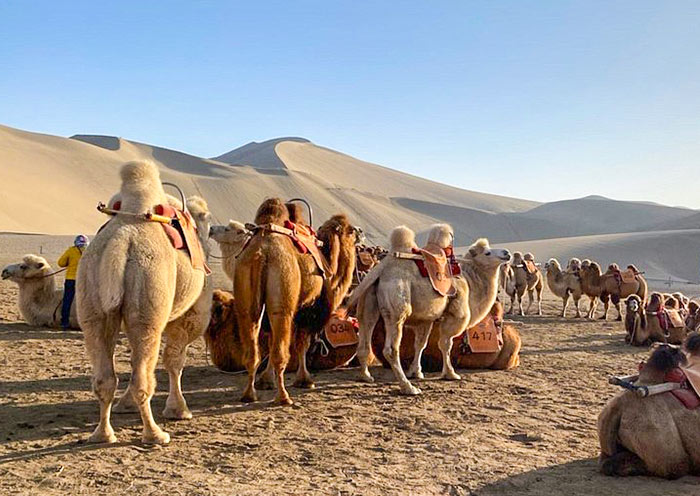
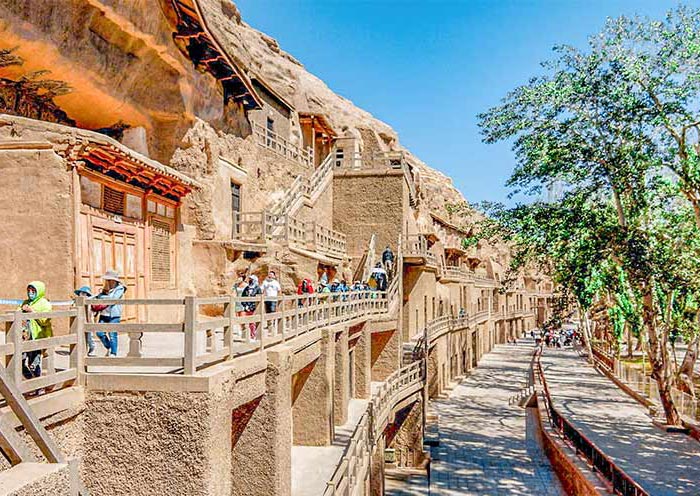
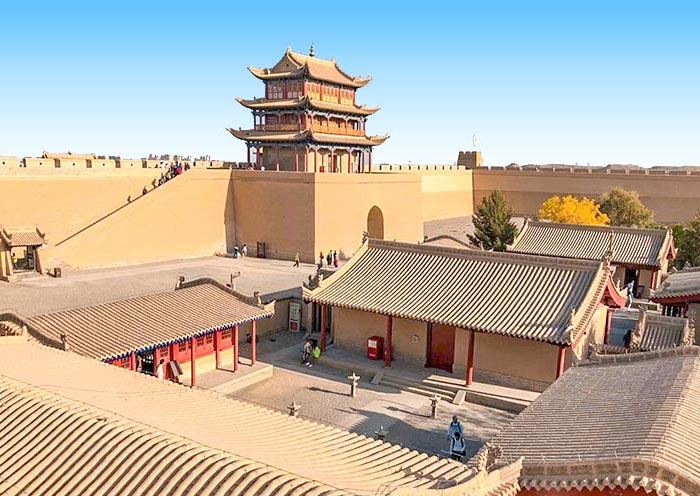
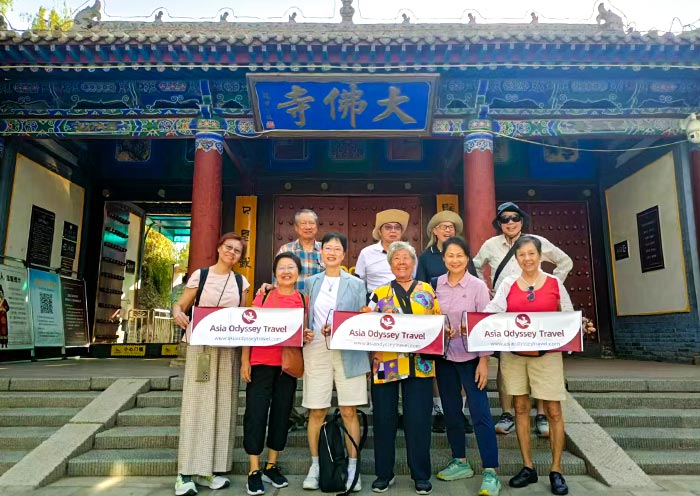
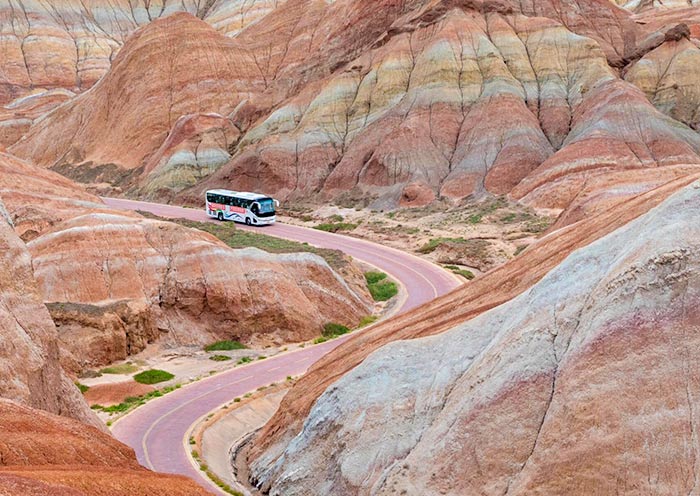
Itinerary at a Glance
Dunhuang (2.5 Days)
Mogao Grottoes (World Heritage), Singing Sand Dunes & Crescent Spring, Dunhuang Museum (Optional), Dunhuang Shazhou Night Market (Optional)
Jiayuguan (1 Day)
Overhanging Great Wall, Jiayuguan Pass (World Heritage - Great Wall of China), Great Wall Museum (Optional)
Zhangye (2.5 Days)
Dafo Temple (Big Buddha Temple), Zhangye National Geopark (Zhangye Danxia Geological Park), Pingshan Lake Grand Canyon, Mati Temple Grottoes (Qilian Mountains)
Itinerary Day by Day
Welcome to Dunhuang, a must-visit city located in the Gansu province of China! Upon arrival in Dunhang, your guide will meet you at the airport and escort you to your hotel. You can explore on your own based on your arrival time. Feel free to seek travel ideas from your tour guide.
Dunhuang, a city in Jiuquan (酒泉市), which was formerly known as Suzhou (肃州), is the birthplace of the "su" character in Gansu Province (甘肃的“肃”). Dunhuang is a desert oasis of ancient wonders. Discover the hidden gems of China's western frontier. Explore the breathtaking Mogao Caves, a UNESCO World Heritage Site adorned with vibrant murals and intricate sculptures. Trek through the Gobi Desert, marveling at the Crescent Lake's turquoise waters and towering sand dunes. From stargazing under pristine skies to experiencing the thrill of sandboarding, and camel riding, Dunhuang offers a captivating journey through time and nature. Dunhuang is also famous for Tunhuangology (敦煌学), a specialized field of study dedicated to exploring and interpreting the vast cultural and historical treasures in the Mogao Caves.
Free Time Ideas:
1. Dunhuang Museum (敦煌博物馆; Closed on Mondays; Reservation Required): It has distinctive architecture, blending cultural symbols such as the Great Wall, beacon towers, and ancient castle-style buildings in its exterior and color scheme. It houses over 13,355 cultural relics from the Neolithic period to the Ming and Qing Dynasties. The most treasured items include ink writings on hemp paper from the Western Han Dynasty (8 BC), a torch made of reeds from the Han Dynasty, and the Beiliang Stone Pagoda. Additionally, there is a 1:1 replica cave of Cave 45 (Tang Dynasty; 8th century) from the Mogao Caves, allowing you more time to admire and photograph the replicas up close.
2. Dunhuang Shazhou Night Market (敦煌沙洲夜市) for Dunhuang food. There are many distinctive snacks that you must try, such as Apricot Skin Water (杏皮水), Donkey Meat Noodles (驴肉黄面), and Bubble Oil Cakes (泡儿油糕). The locals in Dunhuang enjoy eating lamb, chicken, and beef, and they are good at noodle making.
Arrival Ideas:
1. How to get to Dunhuang By Air: Dunhuang Mogao International Airport (敦煌莫高国际机场; or Dunhuang Airport) is located about 13 km from city center and 22 km from the Mogao Caves. Direct flights connect Dunhuang with major cities in China, such as Beijing (3h 45min), Shanghai (4h 25min), Chengdu (2h 40min), Xian (2h 40min), Lanzhou (1h 35min)... It's essential to check flight schedules in advance, as not all routes operate year-round.
2. How to get to Dunhuang By High-speed Train: Dunhuang can be reached by train through Dunhuang Railway Station and Liuyuan Railway Station. Dunhuang Railway Station is situated 10 km from the city center and offers bullet trains from Lanzhou (8-9 hrs) and Jiayuguan (3 hrs). Liuyuan Railway Station, around 130 km from downtown Dunhuang, provides high-speed trains to Urumqi (4.5 hrs), Jiayuguan (2 hrs), Zhangye (3-4 hrs), Turpan (3.5 hrs), among others. Normal trains from major cities like Beijing, Shanghai, and Chengdu also make stops at Liuyuan station.
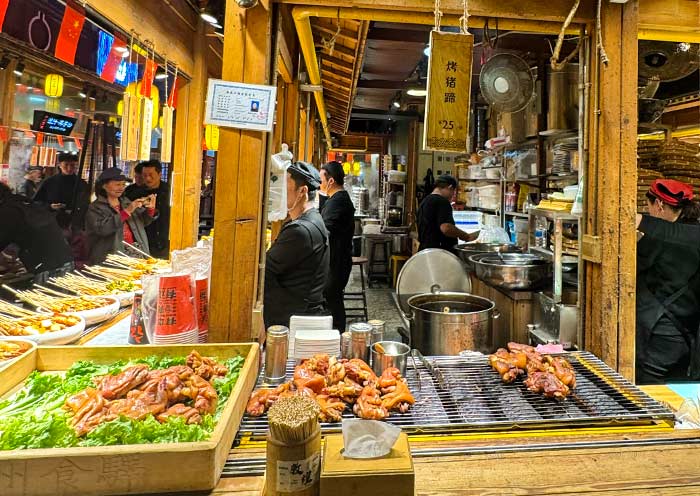
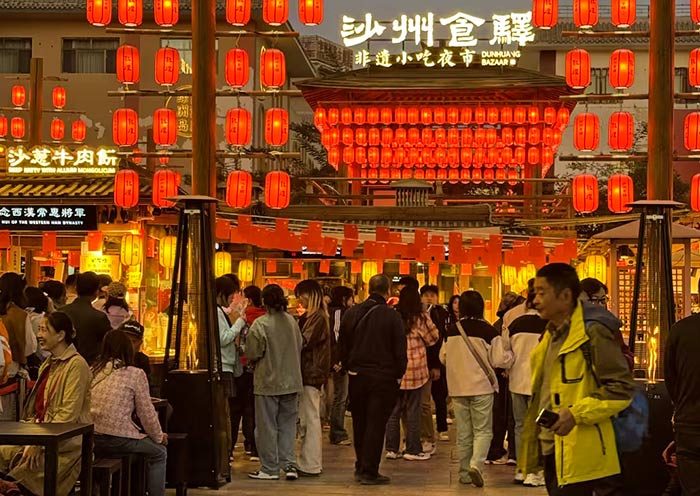
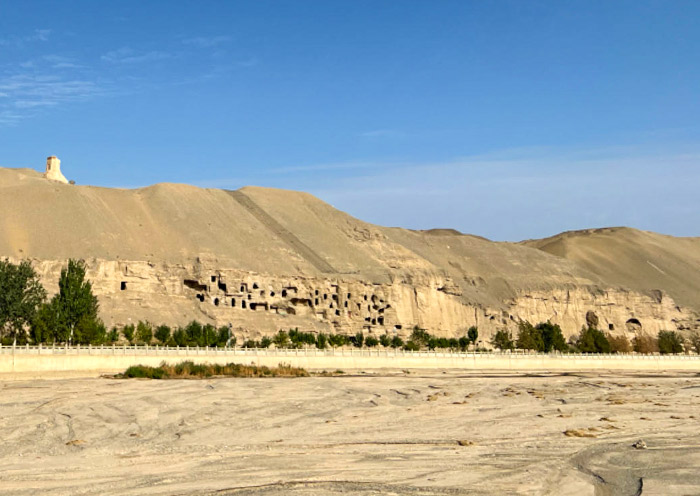
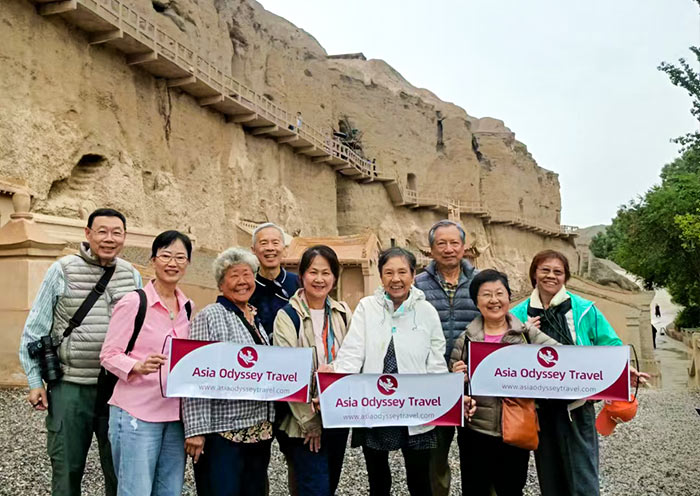
Today, you will enjoy a wonderful Dunhuang Culture Tour by visiting Mogao Grottoes (4-4.5hrs), a UNESCO World Heritage site. You can enjoy the relaxing time in Mingsha Mountain & Crescent Lake, don’t miss the delicious food at the local market.
Dunhuang Mogao Grottoes is the must-visit place for a trip to Gansu. You may have read many stories about A. Stein (斯坦因a British archaeologist and explorer) and the vast trove of artifacts (Paintings, Sculptures, Manuscripts) he brought from the Mogao Grottoes in the early 20th century. You may have already seen the artifacts Stein collected in the British Museum in London. Or you may have heard of Paul Pelliot (French archaeologist & Sinologist) who like A. Stein, conducted several expeditions to Dunhuang and collected a large number of artifacts which is primarily housed in the Guimet Museum in Paris, France. Welcome to visit Mogao Grottoes the source of the world famous Dunhuang Manuscripts (Dunhuang Yi shu敦煌遗书; Cave 16-17) and explore valuable insights into the history and culture of the Silk Road.
The Mogao Caves (Mogao Grottoes莫高窟), also known as the Thousand Buddha Grottoes (千佛洞), are acclaimed as the "Treasure House of Eastern Art东方艺术宝库." The remaining 735 caves are dotted along cliffs rising about 15-30 m high and over 1,700 m, forming a magnificent spectacle of this world cultural heritage site. Despite the significant loss of artifacts to oversea museums, the Mogao Caves remain one of the world's largest and most richly endowed repositories of Buddhist art. Spanning sixteen kingdoms, Northern Wei, Western Wei, Northern Zhou, Sui, Tang, Five Dynasties, Song, and Western Xia dynasties, the construction of the Mogao Grottoes lasted for over a thousand years until the Yuan Dynasty, resulting in about 45,000 ㎡ murals and 2,415 clay sculptures. In the year 366 AD, the first cave of the Mogao Caves was carved into the cliff by the Monk Le Zun (乐僔; over 1,650 years ago). In the 7th century, Xuanzang (唐僧) translated numerous Buddhist scriptures at the Mogao Caves. In 1900, Daoist Wang (王圆箓) discovered the Library Cave (藏经洞; Sutra Cave; Cave 16). From 1941 to 1943, Zhang Daqian (张大千), a prodigious Chinese artist of the twentieth century, copied 276 murals here.
At the Mogao Caves, you can explore various types of grottoes (large statue caves, Nirvana caves, central pillar caves, vaulted ceiling caves, hall caves) and learn about the pigments used by ancient artists in painting murals (cinnabar, orpiment, azurite, mica, gamboge, gold leaf, shell powder). You can admire narrative paintings of Buddhist themes (the life of Shakyamuni Buddha, the Nine-Colored Deer Sacrificing Itself to Save Others), diverse clay sculptures (Buddha statues, Bodhisattva figures, guardians, deities), Flying Apsaras (飞天) and Swirling Dances (Sema; 胡旋舞) in the prosperous Tang Dynasty, as well as the attire and customs of patrons from various dynasties. At the Mogao Caves, you can witness the brilliance and charm of the ancient Silk Road and the efforts and achievements of generations of cultural heritage preservation workers and researchers (such as Chang Shuhong常书鸿, a Chinese painter known as the "guardian of Dunhuang"敦煌守护神).
You can start at the Mogao Caves Digital Center (莫高窟数字中心), watch a 40-minute digital film, and then take a shuttle bus to the caves. Guided by the site interpreters, you will visit 8 caves sequentially (Ticket A; no photography allowed inside the caves). You may have the chance to see significant caves like the Library Cave (Caves 16-17; the largest cave), the Nine-Storey Tower (Cave 96; one of Mogao's iconic structures; the largest Buddha statue), the Nirvana Sutra Cave (Cave 148; reclining Buddha), the Early Tang Treasures Cave (Cave 332), and the Northern Wei Masterpieces Cave (Cave 257). The actual eight caves visited may vary based on the site's conditions. If interested, you can visit the Cultural Relics Protection and Display Center (文物保护陈列中心) to see 1:1 replicas of eight special caves, including Caves 275, 249, 285, 419, 220, 217, 25, and 3 (photography allowed). After the tour, you can return to your hotel to rest after lunch.
Optional Visiting Place:
Coffee Time in Dunhuang Book Center (敦煌书局Reservation required): A popular spot in Dunhuang, a modern lifestyle aesthetic space that combines reading, cultural creativity, coffee, and events.
In the afternoon, time to visit Mingsha Mountain & Crescent Lake (鸣沙山月牙泉) and even sit on the peak of Singing Sand Dunes (1,715 m) to wait for a stunning sunset in front of the Crescent Spring. The Singing Sand Dunes & Crescent Lake is praised as “one of the Top 5 Most Beautiful Deserts in China," "China's Best Natural Landscape Tourist Destination," and "China's Most Beautiful Moon-watching Spot." It is a geological park known for the unique spectacle of mountains, spring, and sand coexisting in the desert. You can enjoy various activities (self-pay) such as camel riding, sand sliding, desert motorcycles, off-road vehicles, helicopters, gliders... You will meet people in costumes of traditional Han clothing or Flying Apsaras.
The Mingsha Mountain is named for the sound produced by the moving sands, with recorded volumes of the singing reaching up to 83 decibels. This phenomenon of sand-producing sound is one of the Dunhuang Eight Views, known as "ShalingQingming沙岭晴鸣" in the Dunhuang County Chronicles《敦煌县志》, where Dunhuang's ancient name of Shazhou (沙洲) also originates. The Singing Sand Dunes stretches from the Mogao Caves in the east to the Dang River in the west, spanning about 40 km east to west and 20 km north to south. The mountain is formed from deposits of fine sand in five colors (red, yellow, green, black, white). The sand of Mingsha Mountain is carried by the wind from the Gobi Desert and the Kumtag Desert to settle here, gradually accumulating over time. The Crescent Lake is nestled amidst the Mingsha Mountain, named for its crescent moon-like shape. The spring water spans 242 meters from east to west and can reach up to 50 meters wide from north to south, with an average depth of around 1.5 meters. The spring is home to the Ironback Fish (铁背鱼local fish) and Seven Star Grass (七星草; medicinal herb) which is included in the "Three Treasures of Crescent Spring月牙泉三宝" by locals (the third one is Five-colored Sand五色沙), believed to bring good luck to people. So try your luck to find them. Remarkably, the sand has not encroached upon the spring, and the water remains clear and abundant, traversing through time, creating the world wonder of the "First Spring in the Desert沙漠第一泉."
Optional Evening Show: (Reservation Required)
1. "Ancient Sound of Dunhang《乐动敦煌》" (available yearround) is the world's first cave-style immersive theatrical experience, telling the story of a young man from the Western Regions named Bai Xin in the early years of the Tang Dynasty who discovers the essence of music in the dancing murals of Dunhuang. Using modern technology and combining live performances, the performance reproduces cultural elements such as music, dance, poetry, costumes, and paintings from the Dunhuang murals.
2. "Dunhuang Celebration《敦煌盛典》" (peak season only) is the world's first large-scale desert live performance, set against the backdrop of the Crescent Lake in the Mingsha Mountain. The unique feature of a 360-degree rotating and movable audience seat enhances the tragic love story of the young painter and the princess, reimagining the former prosperity of the ancient Silk Road and showcasing the unique cultural and folk customs of Dunhuang (including "Iron Flower").
3. "Encore Dunhuang《又见敦煌》" (peak season only) is a large-scale indoor experiential drama directed by Wang Chaoge王潮歌, one of the chief directors of the 2008 Beijing Olympics. Audience members "journey" through the scripture caves, Mogao Caves, and Silk Road, experiencing Dunhuang culture and the Silk Road firsthand.
4. "Thousand-Handed, Thousand-Eyed《千手千眼》" (peak season only) is a large-scale theatrical production performed by the China Disabled People's Performing Art Troupe, showcasing the folk story of "Wonderful Kindness Saves Father." The dance movements are graceful, with deep cultural significance and extremely high artistic standards.
Notes:
1. To protect the caves, the Mogao Caves implemented a real-name reservation system for timed visits, implementing a daily limit on the number of visitors. The ticketing system includes A/Regular tickets (6,000 tickets/day) and B/Emergency tickets (12,000 tickets/day; for domestic visitors only). A Ticket includes access to 8 caves and 2 digital movies. B ticket includes access to 4 caves and the Cave Artifacts Conservation and Research Exhibition Center.
2. Visitors must follow the visitingarrangement set by the management of the Mogao Caves on the day of the visit. The visiting order of the Mingsha Mountain and the Mogao Caves is subject to change.
3. If you are particularly interested in the caves, you can also purchase tickets for special caves at the site (may require queuing) to explore more exquisite caves. The special caves (self-pay) are divided into Line 1 (Caves 45, 320, 321, 420, 9) and Line 2 (Caves 275, 45, 156, 158, 159).
4. During the Dunhuang Cultural Expo or in case of inclement weather or other factors affecting the visit, if the Mogao Caves cannot be visited as planned, our company will refund the Mogao Caves tickets according to the actual cost, or arrange a visit to the Western Thousand Buddha Caves as an alternative.
5. Optional activities in the Mingsha Mountain Scenic Area: Shoe covers; Sightseeing vehicle; Camel riding; Motorcycle; Off-road vehicle (seats 3 people); Paragliding; Helicopter (seats 3 people).
6. When participating in desert recreational activities, take care of your photographic equipment and prevent sand from entering the camera. When riding a camel, follow the staff's instructions when mounting and dismounting.

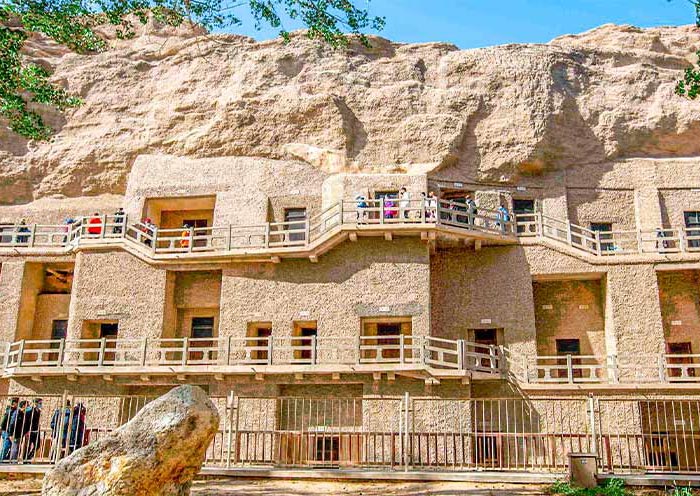
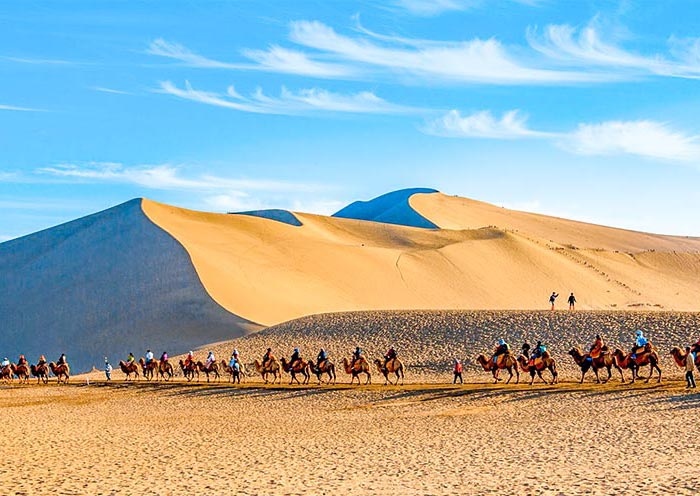
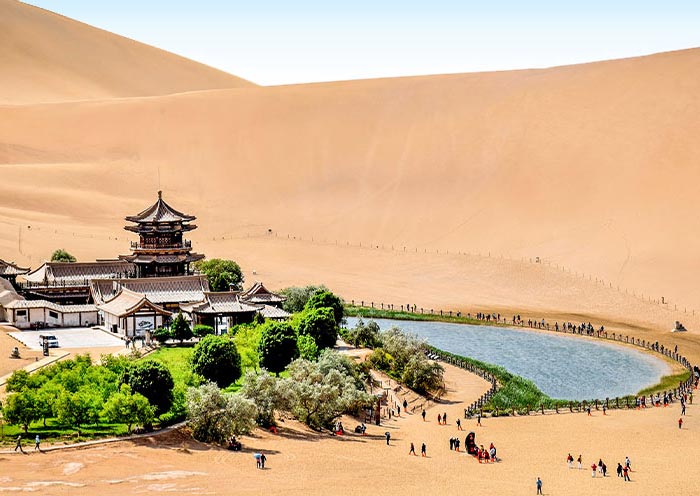
Today, you will head to Jiayuguan (400km, 5hrs) to explore Jiayuguan City for the Great Wall on the Cliff (Overhanging Great Wall) & the Jiayuguan Pass (Jiayuguan Fortress). Jiayuguan is a good place to grasp the essence of a famous Chinese poem that goes, 'In the boundless desert, lonely smoke rises straight; Over the endless river, the sun sinks round大漠孤烟直,长河落日圆'.
You will climb the Great Wall on the Cliff (Overhanging Great Wall悬壁长城) which was acclaimed as the "end of the Great Wall". It was constructed in 1539 (Ming Dynasty) and only 750 meters remain. As the northern extension of the Jiayuguan Pass, it was built following the natural terrain, using local gravel and loess, the steepest section reaches about 45 degrees (over 200 m), earning its name for its appearance of hanging upside down in the air. After renovations in 1987, it consists of parapets, crenellations, and platforms. Two additional platforms were added at both ends, totaling three platforms. Climbing along the Great Wall trail (over 400 steps; kid-friendly ) to the highest watchtower, you can admire the magnificent scenery both inside and outside the Great Wall. From the desert landscapes beside the expressway to the towering chimneys in the oasis, every sight is breathtaking. Here, you can discover the remnants of ancient warfare and beacon fires while marveling at the wisdom of ancient military defense and the rapid development of modern civilization.
After that, visit Jiayuguan Pass (嘉峪关关城). Built in 1372, Jiayuguan is known as one of the "Three Great Passes of the Great Wall of China中国长城三大奇观之一" (Shanhaiguan Pass in the east, Zhenbeitai Terrace in the middle, and Jiayuguan Pass in the west). Standing atop the Jiayuguan Pass, a part of the UNESCO World Heritage Site "The Great Wall of China", you can feel the magnificence and grandeur of this ancient military defense structure. Jiayuguan is the Westernmost Pass of the Ming Great Wall, in the middle of the Hexi Corridor. "Jiayu" means "beautiful valley." Nestled against mountains and water, with its strategic location and majestic architecture, it is renowned as the "The Impregnable Pass under Heaven天下第一雄关."
From the Jiayuguan Pass walls, you can see the Great Wall traversing the desert and the Gobi, while the beautiful Qilian Mountains (祁连山Snow Mountains) and the Heishan Mountains (黑山) act as natural barriers, stretching across the north and south of Jiayuguan. The magnificent scene described in the elementary school Chinese textbook "The Great Wall《长城》" - "From Shanhaiguan in the east to Jiayuguan in the west, spans over 13,000 li (Chinese miles)从东头的山海关到西头的嘉峪关,有一万三千多里" - finds perfect embodiment here.
You might imagine over 600 years ago when this place was a battleground where the Great Walls were built and met with the Ancient Silk Road, connecting the Central Plains (中原) with the Western Regions (西域), and witnessing numerous commercial exchanges and cultural interactions. During the Western Han Dynasty (202 BC-8 AD), Zhang Qian (张骞) passed through here three times to open up the Western Regions, and General Huo Qubing (霍去病) departed to battle the Huns, or Xiongnu (匈奴). During the Tang Dynasty (618-907), Monk Xuanzang (玄奘) passed through here to retrieve Buddhist scriptures. Marco Polo (马可.波罗) traveled through China in the Yuan Dynasty (1206-1368) and visited Jiayuguan. In 1841 (Qing Dynasty), Lin Zexu (林则徐) was sentenced to exile in Yili, Xinjiang for his involvement in the anti-opium campaign. Passing through Jiayuguan, he composed the poem "Southeast, who compares to this mighty pass东南谁比此关雄."
Today, in Jiayuguan Fortress, you can obtain a passage permit (Optional; Self-pay) and experience the process of entering and exiting Jiayuguan as it was centuries ago. This unique experience transports you through time, back to an era where official "passes" (an early form of passport) were required for passage. The Chinese phrase "qing duo guanzhao " (请多关照literally means please take care of me; similar to nice to meet you) originates from the polite language used by people entering and exiting Jiayuguan, symbolizing mutual care and assistance.
Jiayuguan Pass/Fortress is one of the best-preserved gate cities along the Great Wall, making it a popular destination for architecture enthusiasts. It consists of three overlapping defense lines - the inner city, outer city, and moat - forming a military defense system with watchtowers every five li, beacon towers every ten li, fortresses every thirty li, and a city every hundred li. Jiayuguan is not just a city; it's a legendary tale waiting for you to uncover its secrets. Additionally, Jiayuguan is an oasis at the foot of the Qilian Snow Mountains, with numerous lakes and lush greenery, making it a rare summer retreat. Overnight stay in Jiayuguan.
Optional Visiting Place:
1. Jiayuguan Museumof The Great Wall (嘉峪关长城博物馆): It is located near the Jiayuguan Pass. As the first museum in China to theme on the Great Wall, established in 1989, its exhibitions are divided into four sections: the history of the Great Wall, the military aspects of the Great Wall, the Hexi Corridor section of the Great Wall and the Silk Road, and the ancient and modern aspects of the Jiayuguan Pass. One of the prized possessions in the museum is the "Wild Boar's Hoof," dating back 2,000 years.
2. The First Outpost of the Great Wall (长城第一墩; Self-pay):Located on the way to Dunhuang, the First Outpost of the Great Wall, standing about 10 m high, rises on a cliff about 56 m high near the Taolai River (讨赖河). It is the westernmost platform of the Ming Dynasty Great Wall (墩台; ancient military communication spot). You can witness the historical relics in their original state. With a little walk, you will discover an ancient military camp by the river valley where you can immerse yourself in the harsh lives of the frontier soldiers of that era.
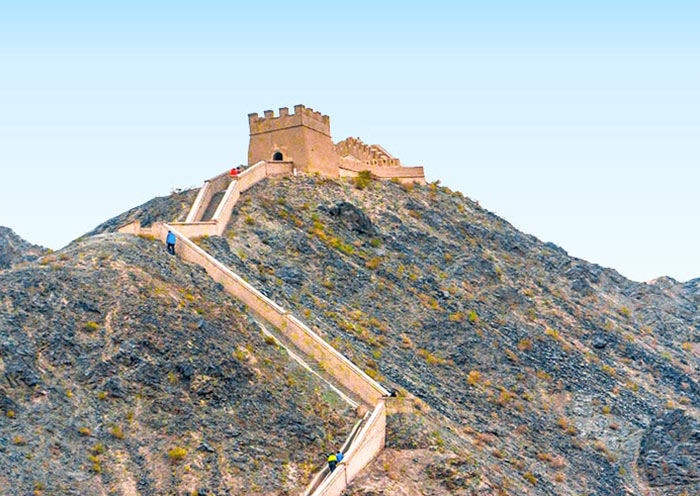
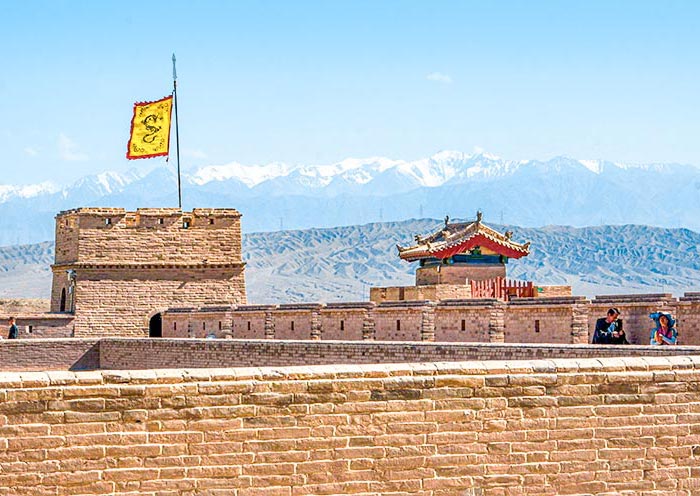
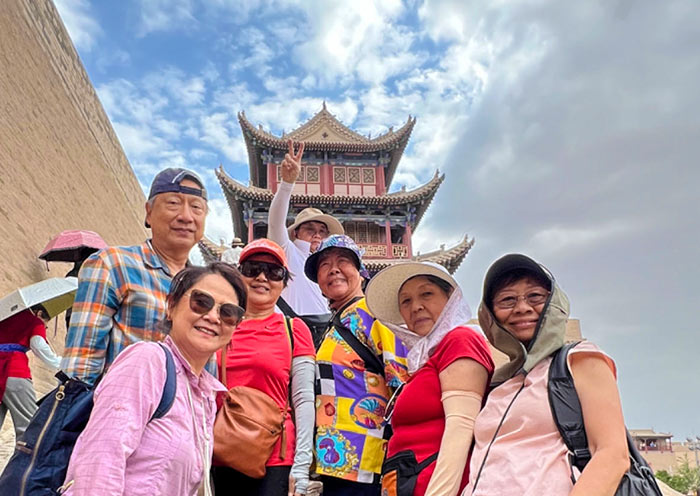
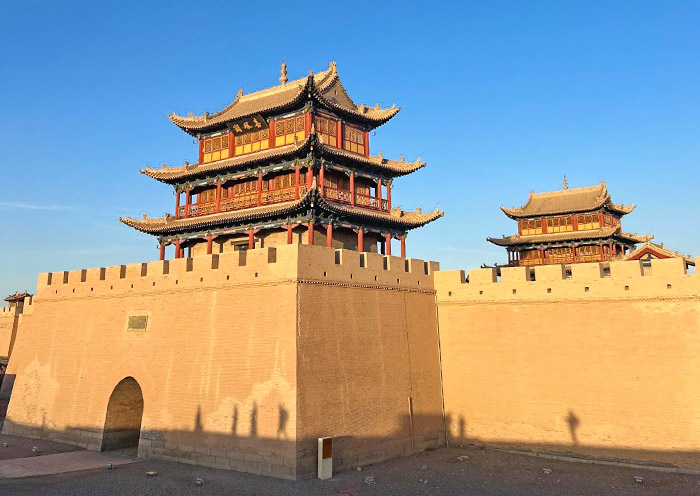
Today, you will head to explore Zhangye City (260 km, 4hrs) through Dafo Temple (1-2 hours) & Zhangye Danxia National Geological Park (3-4 hours; for sunset).
Zhangye is situated in the narrowest section of Hexi Corridor (ancient trading route), spanning just 50 km, yet it boasts fertile soil and pleasant scenery. This is why there is a poetic praise saying, "Not seeing snow on the Qilian Mountains, mistaking Zhangye for Jiangnan 不望祁连山顶雪,错把张掖当江南," and it is also renowned as the "Jiangnan Watertown of Abundance in the Frontier Region 塞上江南" and the "Golden Zhangye金张掖." Formerly known as Ganzhou (甘州, Ganzhou is the place of origin of the "Gan" character in Gansu Province甘肃的“甘”), Zhangye was renamed due to Emperor Wu (汉武帝) of the Han Dynasty's decision to "extend the reach of Zhangye to facilitate connections with the Western Regions 张国臂掖,以通西域," making it a crucial node along the Silk Road and a mandatory stop for the propagation of Buddhist teachings from the East. And you see the airport in Zhangye is called Zhangye Ganzhou Airport (张掖甘州机场).
Dafo Temple (大佛寺; Big Buddha Temple) is a must-visit place in Zhangye if you are particularly interested in Buddhist culture and ancient architecture. The Big Buddha Temple is the iconic building of Zhangye, known for housing a 34.5-meter-long statue of the reclining Buddha, commonly called the "Reclining Buddha Temple 卧佛寺" by locals. Built in the year 1098, the Giant Buddha Temple was a royal temple built by the Western Xia Dynasty (西夏;1038-1227), making it one of the Four Remaining Royal Temples in China (the other three being the Lama Temple in Beijing, the Famen Temple in Baoji of Shaanxi, and the Chongsheng Temple in Dali of Yunnan). Legend has it that Kublai Khan (忽必烈), the founder of the Yuan Dynasty (1271-1368), was born in the Big Buddha Temple in Zhangye. The Italian traveler Marco Polo was captivated by the magnificent architecture of the Giant Buddha Temple and the prosperity of Zhangye, leading him to stay there for a year. Covering an area of over 60,000 m², the temple could accommodate 5,000 worshipers simultaneously in the 16th century.
Visit Big Buddha Temple in Zhangye to explore the only surviving Western Xia temple in China, the largest indoor reclining Buddha in Asia, and the complete Yongle Canon and Prajna Paramita Sutra (《永乐北藏》). It is a Buddhist art museum that integrates architecture, sculpture, murals, carvings, scriptures, calligraphy, and cultural relics. When you step into the temple, you'll see the Grand Buddha Hall which has maintained its original appearance from over 900 years ago. Besides the reclining Buddha, the walls on the east and west sides of the hall feature murals inspired by "Journey to the West西游记," "Investiture of the Gods封神演义," and the "Classic of Mountains and Seas山海经." Among these, the "Journey to the West" mural is said to predate the novel by approximately 200 years, depicting the story of Tang Dynasty Monk Xuanzang (唐僧) and his disciples embarking on their journey to the West in a comic strip format, showcasing episodes like "Fetching Water from the Motherhood River," "A Battle with Red Boy," "Obstacle at Flaming Mountain," "The Monkey King: Uproar in Heaven," and "Expulsion of the Monkey King/Wukong" (取水子母河、大战红孩儿、路阻火焰山、大圣闹天宫、恨逐美猴王). Interestingly, the character Zhu Bajie (猪八戒) in the mural is portrayed as simple, honest, and hardworking, in stark contrast to the Zhu Bajie character in the novel Journey to the West. Even today, within the Zhangye region, one can find many place names from novel Journey to the West, such as Gaolaozhuang (高老庄Bajie's hometown), Liusha River (流沙河), Liangjintai (晾金台), Bull Demon King's Cave (牛魔王洞), and the Eight Thousand Ruoshui River(八千里弱水).
A pair of Chinese characters written on a couplet outside the Grand Buddha Hall reads, "The Sleeping Buddha slumbers a thousand years without awakening, those who inquire will forever question, the answer remains elusive睡佛长睡睡千年长眠不醒,问者永问问百世永问难明," provoking deep contemplation and worth a look. Remember to ask the guide to show you another pair of couplets written in the Western Xia script with the same content. Additionally, the scripture hall of the reclining Buddha temple houses a Buddhist art exhibition hall and a Buddhist scripture exhibition hall, showcasing Buddhist artifacts extracted from the Buddha's abdomen. Among them, the "Mahaprajnaparamita Sutra《大般若波罗蜜多经》" written in gold and silver ink is a treasured artifact. Rare and exquisite Persian silver coins have been discovered in this temple, serving as compelling evidence of the bustling foreign trade along the Silk Road.
Optional Visiting Place: (If Time Permits)
1. Shanxi Guild Hall (山西会馆) : Located next to the Big Buddha Temple, the Shanxi Guild Hall was constructed by Shanxi merchants (晋商) in 1724 with a history of over 300 years for their commercial activities in Zhangye. It is said that "where there is prosperous trade, there are Shanxi merchants; where there are Shanxi merchants, there are guild halls凡商贸繁华处必有晋商,有晋商居处,必有会馆." During the Ming and Qing dynasties, Shanxi merchants built around 400 Shanxi Guild Halls across the country, all characterized by the presence of a Guan Gong Temple (关帝庙; dedicated to Guan Yu拜关羽) and an Opera Stage (西楼).
2. Zhangye City Museum (张掖博物馆Closed on Mondays): Located opposite the Zhangye Big Buddha Temple, the Zhangye City Museum houses over 10,000 cultural relics spanning various historical periods from the Neolithic Age to the Ming and Qing Dynasties. These relics are diverse and include bronze ware, pottery, jade artifacts, as well as cultural remnants from the Silk Road. You can admire a 1:1 replica of the Golden Tower Temple grottoes (金塔寺1:1复制石窟) in this museum.
Note:
Currently, the reclining Buddha statue in Zhangye Giant Buddha Temple is undergoing digital restoration, covered by scaffolding. The project is expected to be completed by June 2025.
In the afternoon, head to visit Zhangye National Geopark (Zhangye Colorful Danxia Scenic Spot七彩丹霞景区) which is renowned for its strikingly colorful rock formations, often referred to as Rainbow Mountains. Zhangye is famous worldwide for its colorful Danxia landforms, a must-visit attraction for people traveling to Zhangye. This is a paradise for geologist & photography enthusiasts, and a great place to experience the marvelous work of nature. The Zhangye Colorful Danxia Scenic Spot (七彩丹霞景区), part of the Zhangye National Geopark, is China's only highly composite area that combines Danxia landforms with colorful hilly landscapes. Zhangye Danxia has been honored as one of the world's top ten geographical wonders, one of the 22 most unforgettable landscapes worldwide, and the most beautiful exterior filming location at the 74th Venice Film Festival. This location served as a filming site for the movie The Great Wall《长城》 directed by Zhang Yimou and Disney's Mulan《花木兰》. The Rainbow Mountains featured on the cover of high school English textbooks are not only geological relics of special scientific significance, rarity, and aesthetic value but also hold archaeological, ecological, historical, and cultural significance.
During the Cretaceous period, approximately 135 to 65 million years ago, the Zhangye region underwent the Himalayan orogeny, multiple erosions by water and wind, and long-term weathering processes, leading to the formation of the current Danxia landforms. The strata are mainly composed of sandstone and mudstone, formed in a dry and hot environment, where divalent iron in minerals oxidized to trivalent iron, giving the strata a red hue. As the environment gradually became wetter, the high-priced iron was reduced, causing a change in strata color to shades of brown, yellow-green, and bluish-gray, creating a palette resembling that of an overturned divine paintbox. The term "Danxia (丹霞)" originates from Cao Pi's poem (曹丕) "Danxia surrounded by the bright moon, with splendid stars emerging amidst the clouds (丹霞夹明月,华星出云间)." "Danxia," literally means the sacred or auspicious celestial sight - the rosy clouds illuminated by light. When geologists first discovered the cinnabar-colored landform, the romantic scientists named it the "Danxia landscape," leading to the coinage of the geographical term "Danxia landform (丹霞地貌)."
The scenic area comprises five Observation Decks (No. 3 and No. 2 have been merged). Shuttle buses connect each Observation Deck (entering and exiting at the north gate, with shuttle stops at four points in the order of Observation Deck #2-1-5-4). Observation Deck #1 and Observation Deck #4 are the most recommended. Yunhai Platform (云海台 No. 1) is where the image was taken on the ticket and the largest viewing platform, offering a panoramic view of the entire Danxia landscape, including the winding S-shaped road. Hongxia Platform (虹霞台 No. 4), highly popular and considered the most beautiful spot with the most vibrant colors, is the best place to watch the sunset. In the eyes of the Chinese people, the Rainbow Mountains here resemble delicious Pork Belly or Strawberry Cake layers.
At the Zhangye Rainbow Mountains, you can admire unique features like the Rainbow Screen, Sleeping Beauty, Giant Scallop, Monks Worshiping Buddha, Monkey Gazing at the Sea, Turtle Asking the Heavens, and the Red Cliff Great Wall (七彩屏、睡美人,大扇贝、众僧拜佛、灵猴观海、神龟问天、赤壁长城). Standing at the mountaintop, one can witness the colorful watercolor-like mountain ranges, feeling as if stepping into a painting.
Optional Visiting Place:
Zhangye UNESCO Global Geopark Museum (张掖地质公园博物馆 Closed on Mondays): You can enter from the North Gate (北门) as it is where the Zhangye UNESCO Global Geopark Museum (Closed on Monday) located. With a visit to the museum that serving as a popular science base for understanding the professional knowledge of Zhangye Danxia Landform, you may get deeper understanding of this Zhangye Danxia National Geological Park (Zhangye Danxia Geopark张掖国家地质公园).
Overnight in Zhangye. Zhangye not only served as a pivotal point for the Tang Dynasty monk Xuanzang's journey (玄奘西行) to the West in search of Buddhist scriptures but is also considered the legendary birthplace of "Journey to the West " (西游记 Wukong). In the evening, Zhangye's night market awaits you, offering a chance to savor authentic donkey meat (驴肉) and apricot skin tea (杏皮茶), allowing you to indulge in a culinary adventure.
Notes:
1. The best time for photography is at sunrise when the light is soft, colors are vivid, and there is a strong contrast, ideal for capturing both the panoramic view and detailed textures of the Rainbow Mountains. Sunset, with the setting sun casting its warm glow on the hills, creating golden silhouettes, is also an excellent time to capture the beauty of the Rainbow Mountains.If you want to capture the sunrise, do double check with your travel consultant to overnight at the hotel near the Rainbow Mountain.
2. Another optimal time to appreciate the Danxia landforms is after rainfall when the colors become evenmore vibrant and captivatingdue to the moisture.
3. Comfortable shoes are essential as climbing uphill sections may occur.
4. The scenic area also offers entertainment options such as camel rides, hot air balloons, gliders, helicopters, and other activities (at an additional cost).
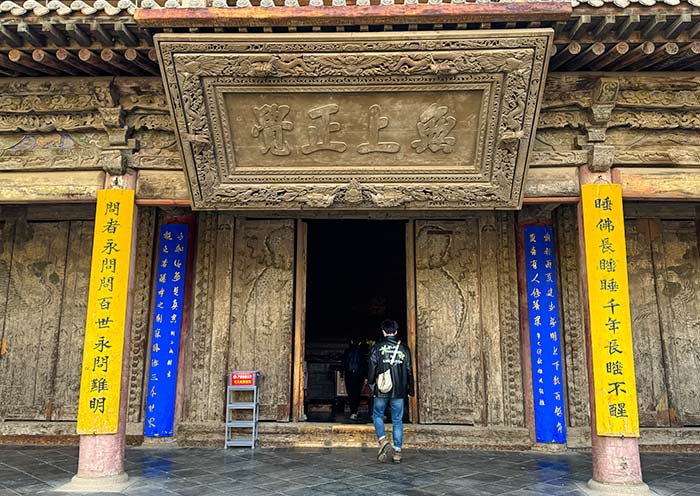
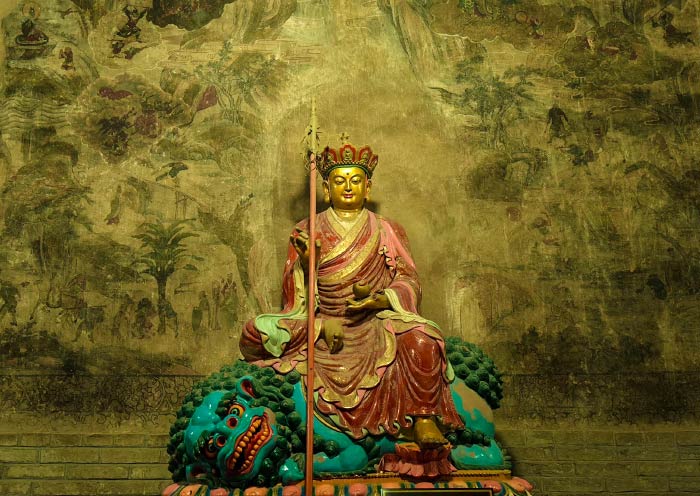
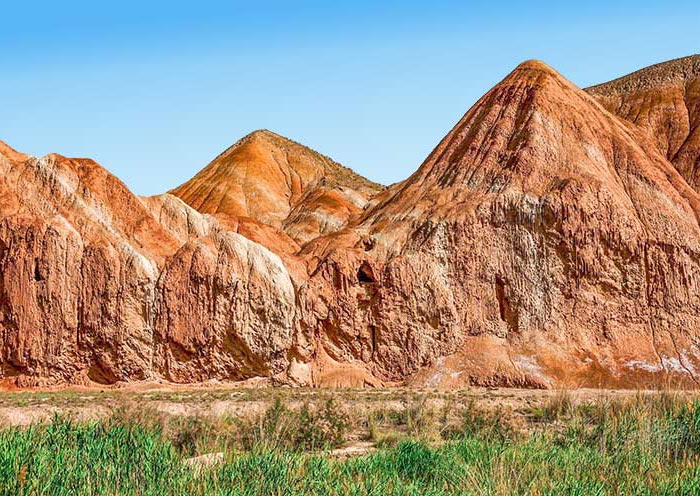

In the morning, you will visit Mati Temple Grottoes (60km, 2h) for the Cave art, snow-capped mountains, forests, streams, grasslands, temples, and Tibetan culture. In the afternoon, head to Zhangye Pingshan Lake Grand Canyon (120km, 2.5h) for the red bed landform.
Mati Temple Grottoes, located under the snow-capped Qilian Mountains (祁连山), offers a cultural experience combined with Ancient Buddhist art dating back to 1,600 years ago and the brilliant natural beauty that is famed as “Little Switzerland”. The Mati Temple Grottoes is situated amidst pine forests and valleys (松林薤谷). The initial grottoes were carved by Guo Yu (郭瑀), a disciple of Confucian master Guo He (儒家大师郭荷), as classrooms for teaching, playing a significant role in the establishment and development of the Hexi culture. Today, the Mati Temple has become one of the important temples of the Gelug sect of Tibetan Buddhism, preserving 37 grottoes rich in relics and over 100 Buddha statues and stupas. You will marvel at the grottoes that are distributed along cliffs or rock walls near water for about 20 km.
The grottoes house more than 500 precious statues from various dynasties like Northern Liang, Northern Wei, Western Wei, Sui, Tang, Yuan, Ming, and Qing, along with over 2,500 square meters of murals. Stepping into Mati Temple, one is struck by the awe-inspiring sight. The ancient grottoes are intricately built into the mountainside, each seeming to narrate millenniums of vicissitudes. The colorful murals, executed with exquisite craftsmanship, are truly breathtaking. Beyond the allure of the grotto art, Mati Temple also boasts rich natural scenery. On clear days, you can climb to the mountaintop, overlooking the magnificent views of the entire Qilian Mountains, experiencing nature's stunning and awe-inspiring craftsmanship.
After lunch, you'll be escorted to Pingshan Lake Grand Canyon (about 57 km, 1 hour). Located northeast of Zhangye, this canyon is a prime example of the red bed landform. Praised by China National Geography magazine, it is often compared to Zhangjiajie National Forest Park and the Grand Canyon in Colorado, and is regarded as a hidden gem along the Silk Road! Its unique geological landscape and immersive canyon exploration make it one of the most captivating attractions in the Qinghai-Gansu travel circuit. As you hike deeper into the canyon, you'll feel the awe of nature shaped over billions of years, with wind and water erosion forming breathtaking natural art that is both vast and inspiring!
After the tour, head back to Zhangye overnight.
Notes:
1. The altitude of Mati Temple is approximately around 2,580 meters. Remember to bring warm clothing!
2. Climbing the grottoes requires some physical strength. It is recommended to wear comfortable shoes.
3. The weather in the hinterland of the Qilian Mountains is changeable. It is advisable to carry an umbrella for any unexpected needs.


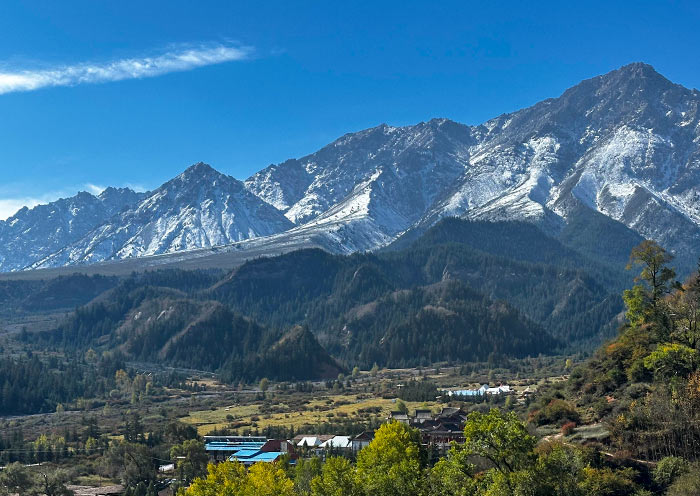
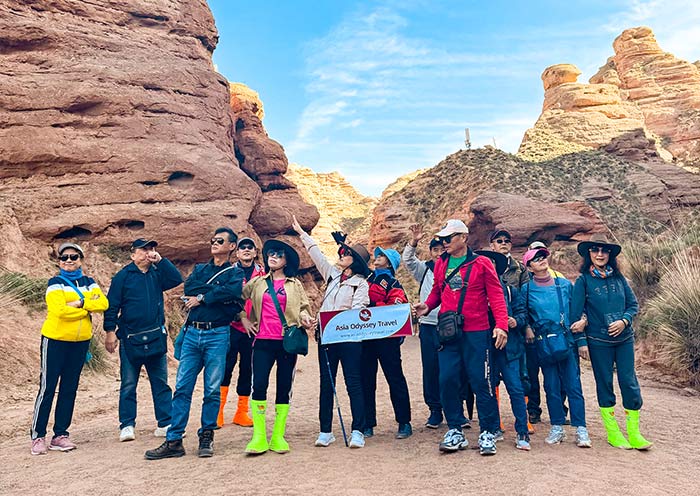
It is time to end your 6 Days Best Gansu Tour. Thank you for choosing Asia Odyssey Travel for your China Tour, and we are always here working for you and hope to see you again for your next trip to Asia. Safe journey!
Extension Ideas:
1. If you wish to extend your trip and explore other highlighted parts of Gansu, such as Dunhuang, Zhangye, Lanzhou, Jiayuguan, Wuwei, Jiuquan, Guazhou, and more, we can help you with the arrangements.
2. If you plan to continue your exploration to other cities in China, such as Xining, Turpan, Chengdu, Lhasa, Xian, Beijing, and Shanghai, please feel free to let us know. We can customize your itinerary and assist you with travel arrangements.
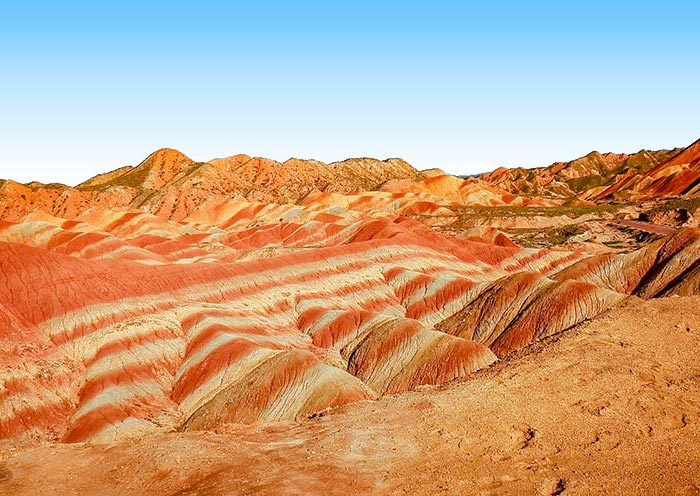
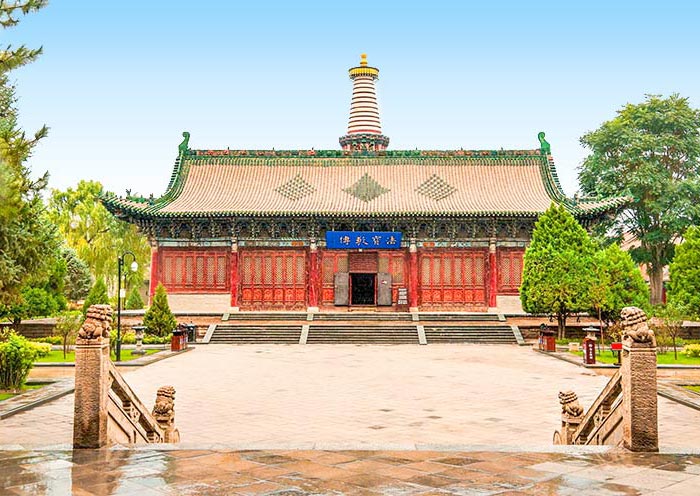
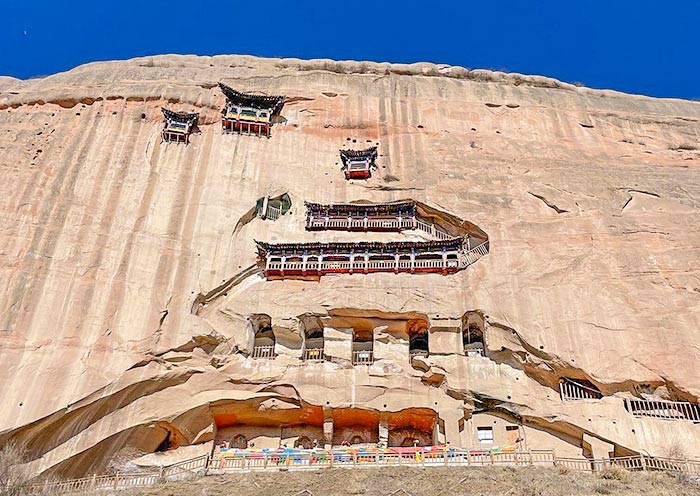
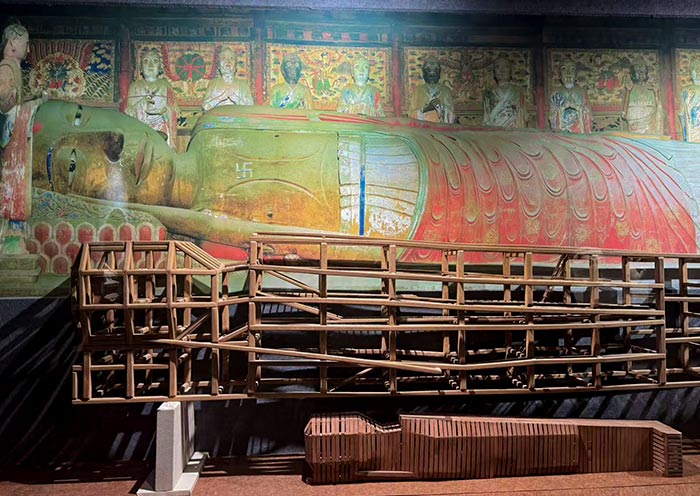
Price: What’s Included & What’s Excluded
What's Included:
What's Excluded:
Hotel Conditions for Gansu & Silk Road Tours
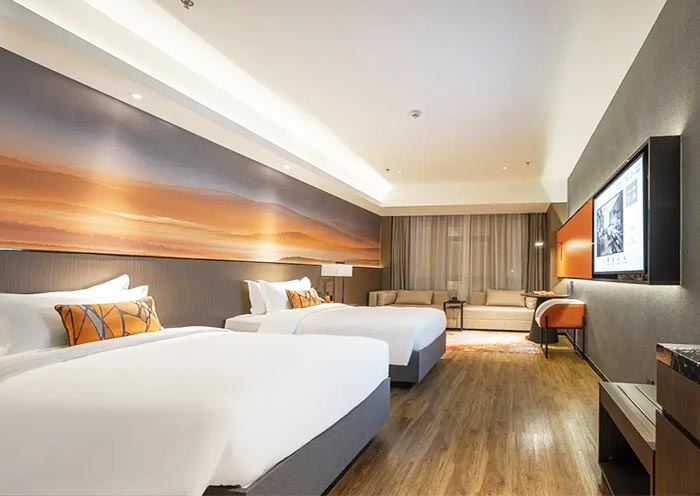

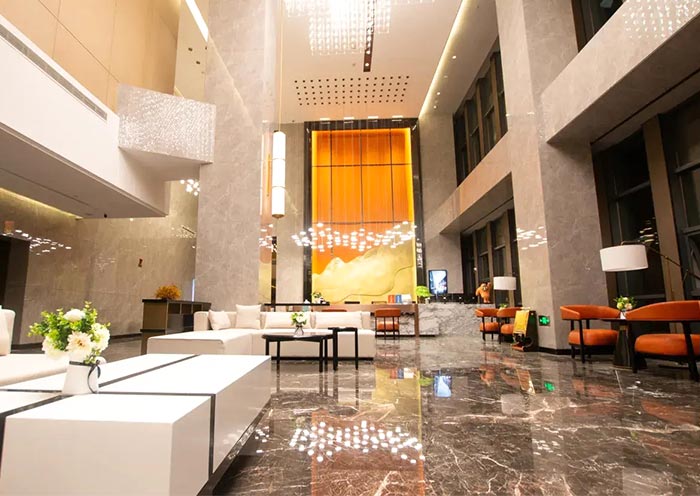
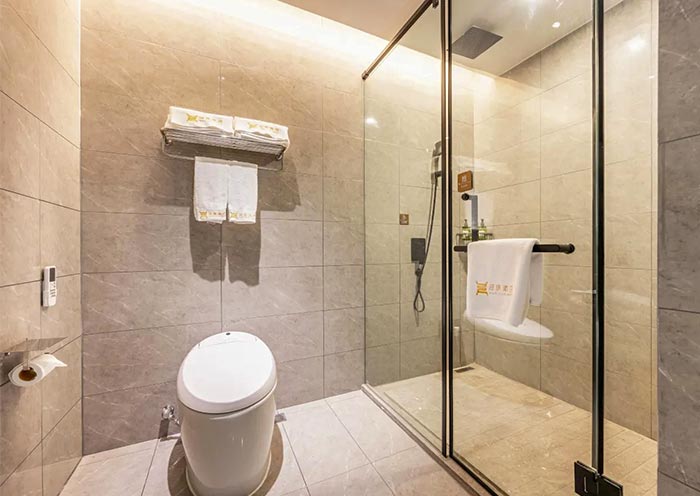
3 to 5 Star Hotels on the Silk Road Route Destinations:
Enjoy comfortable 3-star, 4 star or 5 star hotels along the Silk Road route, offering essential amenities for a relaxing stay after each day's adventures. These hotels provide a welcoming atmosphere with friendly service, perfect for Silk Road travelers.
Recommended Length to Stay (Xinjiang, Gansu & Qinghai)
To fully experience the Silk Road's highlights, we recommend a silk Road tour of 5-12 days. (1) One-Destination Deep Dive: Immerse yourself in the wonders of either Xinjiang (3-5 Days) or Gansu (5 Days). (2) Classic Silk Road Experience: Combine Xinjiang and Gansu together for a comprehensive exploration.(3) Ultimate Silk Road Journey: Extend your trip to include Qinghai and experience China’s diverse landscapes.
Standard Twin Room
Standard twin rooms on Silk Road group tours feature two comfortable beds, private bathrooms, and basic amenities. These rooms are designed for travelers seeking a cozy, convenient space to rest and recharge during their Silk Road journey.
Photo Gallery for This Itinerary
Latest Gansu Tours Reviews from Our Customers

Sam Lin
Singapore
Date of Experience: Dec 24, 2024
Tour Customized by: Vincent
You May be Interested in This Tour: 8 Days Best Japan Group Tour: Japan Highlights & Hiroshima

Zhang Xin Hua
Malaysia
Visiting Japan’s Golden Route in October was incredible! From Tokyo's vibrant city life to the serene beauty of Mount Fuji, every stop was unforgettable. Kyoto’s temples and Nara’s friendly deer captured Japan’s charm, while Osaka’s food scene was a delight. The mix of tradition and modernity made it a perfect 7-day journey!
Date of Experience: Oct 26, 2024
Tour Customized by: Allan
You May be Interested in This Tour: 7 Days Japan Golden Route Tour in Small Group

Dan Z
Washington DC
Date of Experience: Aug 24, 2024
Tour Customized by: Rex
You May be Interested in This Tour: 7 Days Japan Kansai Tour with Hiroshima: Osaka, Kyoto, Uji & Nara
Price: Request
(Based on a private tour for two people. Price varies depending on program, travel date, number of people.)
Free Enquiry! You don’t need to pay for the reservation.
- United States (+1)
- Australia (+61)
- Singapore (+65)
- Malaysia (+60)
- Philippines (+63)
- Canada (+1)
- Italy (+39)
- Indonesia (+62)
- United Kingdom (+44)
- Spain (+34)
- Mexico (+52)
- Hong Kong (+852)
- Thailand (+66)
- United Arab Emirates (+971)
- New Zealand (+64)
- South Africa (+27)
- Germany (+49)
- Brazil (+55)
- India (+91)
- France (+33)
- Vietnam (+84)
- The Netherlands (+31)
- Saudi Arabia (+966)
- Ireland (+353)
- Argentina (+54)
- Switzerland (+41)
- Romania (+40)
- Pakistan (+92)
- Japan (+81)
- Portugal (+351)
- Bangladesh (+880)
- South Korea (+82)
- Puerto Rico (+1)
- Türkiye (+90)
- China (+86)
- Belgium (+32)
- Qatar (+974)
- Greece (+30)
- Taiwan (+886)
- Austria (+43)
- Poland (+48)
- Israel (+972)
- Chile (+56)
- Sri Lanka (+94)
- Nigeria (+234)
- Peru (+51)
- Colombia (+57)
- Hungary (+36)
- Nepal (+977)
- Denmark (+45)
- Bulgaria (+359)
- Norway (+47)
- Slovenia (+383)
- Sweden (+46)
- Kuwait (+965)
- Costa Rica (+506)
- Ecuador (+593)
- Venezuela (+58)
- Malta (+356)
- Croatia (+385)
- Tunisia (+216)
- Czechia (+420)
- Mongolia (+976)
- Bahrain (+973)
- Mauritius (+230)
- Papua New Guinea (+675)
- Cambodia (+855)
- Dominican Republic (+1)
- Luxembourg (+352)
- Finland (+358)
- Guatemala (+502)
- Myanmar (+95)
- Maldives (+960)
- Slovakia (+421)
- Laos (+856)
- Serbia (+381)
- Brunei (+673)
- Oman (+968)
- Macao (+853)
- Panama (+507)
- Morocco (+212)
- Jordan (+962)
- Georgia (+995)
- Fiji (+679)
- Bolivia (+591)
- Lithuania (+370)
- Bahamas (+1)
- Cyprus (+357)
- Latvia (+371)
- Bhutan (+975)
- Iraq (+964)
- Iran (+98)
- Kenya (+254)
- Jamaica (+1)
- Zimbabwe (+263)
- Azerbaijan (+994)
- Uruguay (+598)
- Estonia (+372)
- Andorra (+376)
- Cameroon (+237)
- Ghana (+233)
- Kazakhstan (+7)
- Nicaragua (+505)
- Egypt (+20)
- Russia (+7)
- Albania (+355)
- Réunion (+262)
- Montenegro (+382)
- Algeria (+213)
- Afghanistan (+93)
- Martinique (+596)
- Uganda (+256)
- Honduras (+504)
- North Macedonia (+389)
- Trinidad and Tobago (+1)
- Suriname (+597)
- Antigua and Barbuda (+1)
- Zambia (+260)
- Ukraine (+380)
- Armenia (+374)
- Barbados (+1)
- Belarus (+375)
- Palestine (+970)
- Lesotho (+266)
- Moldova (+373)
- Ethiopia (+251)
- French Polynesia (+689)
- Gambia (+220)
- Guam (+1)
- Gibraltar (+350)
- Isle of Man (+44)
- New Caledonia (+687)
- El Salvador (+503)
- Comoros (+269)
- Seychelles (+248)
- Chad (+235)
- Samoa (+685)
- Cook Islands (+682)
- Palau (+680)
- Paraguay (+595)
- DR Congo (+243)
- Solomon Islands (+677)
